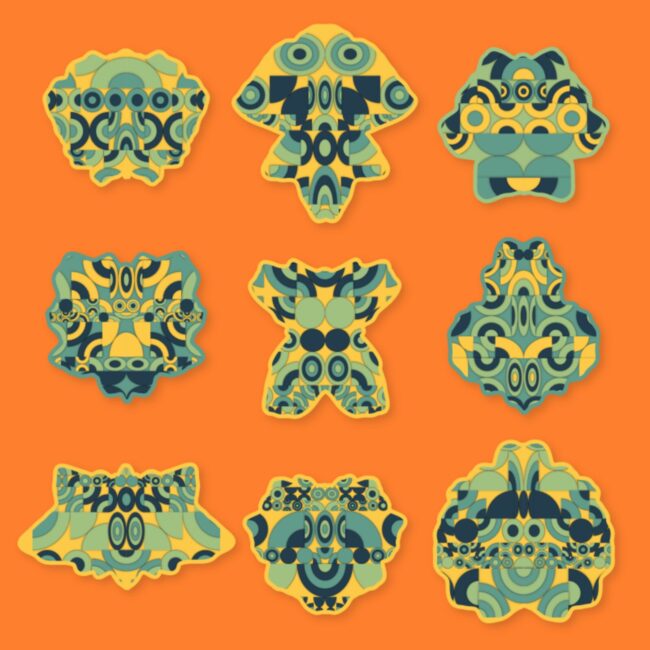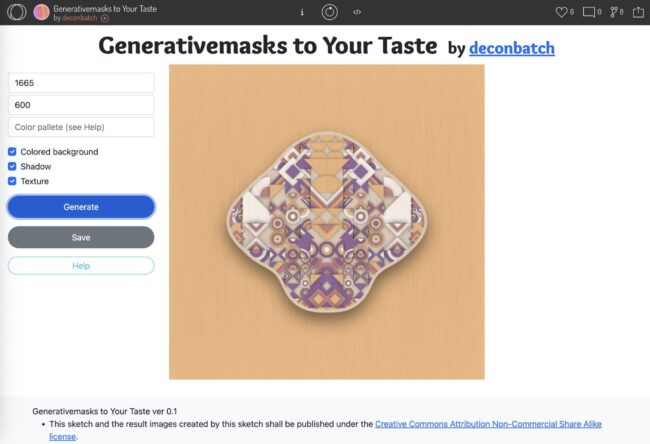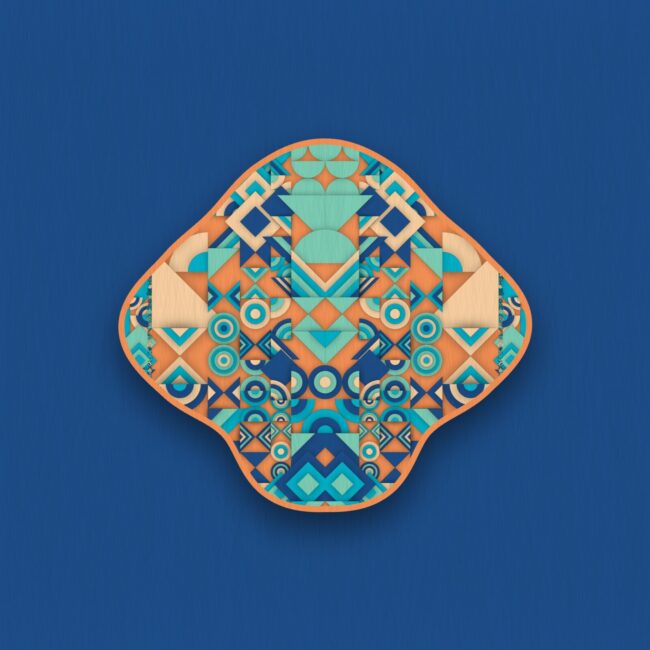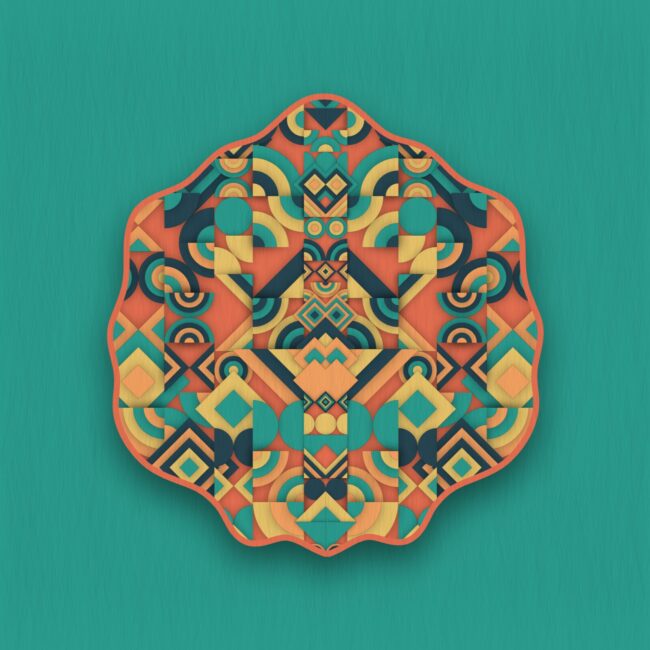The generative art project Generativemasks, released on August 17, 2021, sold out all 10,000 pieces within just a few hours and was engraved in cultural memory as a historic work. It was an event that unfolded in the very midst of the NFT bubble of 2021. Thereafter, Generativemasks became an iconic piece at the intersection of generative art and PFPs, NFTs and creative coding—going beyond mere market success to demonstrate the potential of code as a medium for new forms of expression and community-building. In parallel, numerous workshops, exhibitions, and initiatives that encouraged human interaction began to take shape. Its influence continues to spread beneath the surface of the digital art field, echoing outward. Now, four years after its release, this text seeks to revisit what Generativemasks has brought forth, and to reexamine the significance it holds.
Origins
The origins of Generativemasks trace back to a conversation in the spring of 2021 between artist and creative coder Shunsuke Takawo and Toshi of TART (now NEORT). Toshi approached Takawo—who had accumulated numerous prototypes through his “daily coding” practice exploring visual expression via everyday programming—about doing a project on the blockchain. At first, Takawo knew little about blockchain or NFTs, but prompted by Toshi’s proposal to base it on sketches of symmetric, mask-like patterns, a bold plan was set in motion: “Then let’s generate 10,000 masks.”

A sketch containing the algorithm that became the basis for Generativemasks
https://openprocessing.org/sketch/1158126
The prototype of Generativemasks began in April 2019 with a simple dot graphic.
https://openprocessing.org/sketch/716372
Although the reaction on social media wasn’t that big yet, I remember that Takawo himself felt a strong sense of traction with the antecedent work. His pieces have a distinctive, living quality and felt particularly unique within generative art. I sensed the work had the potential to become a symbolic presence for the Web3 and digital art community. —Toshi
Then came the August 2021 launch. At the time, PFP-style collections were booming explosively on the NFT market, and on-chain generative art represented by Art Blocks was also in the spotlight. Emerging at the perfect moment when these two currents crossed, Generativemasks became a major topic on X (then Twitter) immediately after launch, sold out within hours, recorded over 1,000 ETH in trading volume by that night, and broke into the top five of OpenSea’s 24-hour trending—an exceptional surge that far exceeded the team’s expectations.
To be honest, I wasn’t sure whether 10,000 was the right number—some even called it a “brutally large number.” I was watching the mood around us, but even before that I had hope because about 40 works by the generative artist Okazz had sold out instantly. —Toshi
International ripple effects also underpinned the project’s success. From immediately after release it became a topic among overseas NFT aficionados and the generative art community; references by prominent collector Karatekid and artist Alexis André further amplified attention. After the sale, a community mediated by Generativemasks expanded. A derivative-art contest held post-release drew numerous digital collages using Generativemasks imagery, catalyzing user-driven creativity. In the metaverse space Decentraland, a “Tribal Dance” event was staged, where participants gathered to dance wearing avatars adorned with masks and costumes using Generativemasks visuals. Volunteer-made Snapchat AR mask filters, a public web tool that let anyone enjoy generating patterns, and more—diverse derivative cultures unfolded with Generativemasks as their starting point.

Generativemasks to Your Taste
by deconbatch
https://openprocessing.org/sketch/1299156
Between Generative Art and PFP
One thing Generativemasks symbolizes is the fusion of generative art and PFP (profile picture projects). At the time of its release, generative-art NFTs led by Art Blocks and PFP NFTs represented by CryptoPunks and Bored Ape had formed communities in different contexts. Generativemasks, however, was a presence that straddled both. Technically it is pure generative art made with Processing/p5.js, yet its sales format followed a PFP-like approach as a 10,000-piece collection.
Looking back, I think the concept of PFP × generative art had a singularity unlike anything else. There was a mass outbreak of “~mask” PFPs back then, and Generativemasks surely carried a critical stance toward that trend. —hasaqui
Art Blocks’ regulations stipulate that a given hash value must produce a fixed output. Toshi felt that such an approach could actually constrain the potential of generative art. Out of that came the idea of “colors changing at random.” As an attempt to present a new possibility vis-à-vis existing rules of generative art, it drew attention.
Art Blocks’ method of producing a uniform, predetermined output from a single hash value is understandable as a painterly aesthetic, but it seemed to me to close off the potential of generative art. That’s why having the colors change with every reload felt fresher—and truer to Generativemasks. In the end, so many people kept reloading and playing that it crashed OpenSea’s servers. Being able to witness that kind of free play naturally turning into culture was wonderful. —Toshi
Mask
The visual theme of Generativemasks is, as the title suggests, “masks.” Yet at that time, there was already a proliferation of PFP collections labeled “~masks,” beginning with Hashmasks. While nodding to that trend, Generativemasks distinguished itself by standing out in its formal completeness as generative art.
Takawo’s algorithm combines geometric patterns arranged symmetrically left and right, giving each graphic a distinctive personality and expression. Within its folkloric forms reminiscent of totem poles, one can discover a variety of characters and traits. Leaving room for diverse readings, it is an open work that stimulates the viewer’s imagination.
We had lively discussions about the features of the work—for instance, giving nicknames to the patterns, or naming the shapes like “Mine is a lion,” “This one’s a shrimp.” There were even requests to quantify the mask size, so we computed area and aspect ratio and had fun with things like “This is the smallest one.” —Toshi
Although it adopted PFP-like methods, Generativemasks notably did not provide a conventional rarity ranking, encouraging collectors to freely choose the masks they liked. This policy reflects Takawo’s aesthetics—wanting to compete on pure artistic appeal without being swayed by market logic—and his belief that all forms of expression should be able to appear as bearing equal value.
Since the internet, forms of identity have changed rapidly, giving rise to new ways of forming communities. Rather than being controlled by a particular someone, people influence things as participants with equal decision-making power. The histories inscribed on blockchains record those moments of decision as traces of the “self.” Generativemasks can be seen as an ornament that celebrates the diversity of people living within the chaotic online culture that embodies such anonymity and multiplicity, and as an expression of the positive values found there.
At the same time, in recent years the negative aspects of that diversity and anonymity have become conspicuous. The “algorithm,” the source of creativity in code art, is being used to stoke malice. The power of the “mask,” which should grant the ability to don another persona, is slipping out of control under the sway of a vast unconscious force that is neither quite human nor purely algorithmic. Faced with the magnitude of that impact, one wonders what culture and art can do.

Generativemasks #1665 Owned by Glimmer DAO
Code Art as Culture
From the mid-2010s onward, Takawo steadily continued to present programming works on social media and was well known among domestic creative coders. The “#dailycoding” movement he helped lead sought to establish programming as an everyday creative act; Generativemasks can be seen as a “serendipitous result” along that continuum. Yet the global spotlight provided by the NFT context transformed Takawo’s position. He established the Generative Art Foundation, taking on a role of supporting related communities and projects in Japan and abroad.
By contributing to the development of generative art as a whole, Generativemasks became a work emblematic of one achievement in code art. But the rapid success also brought Takawo new responsibilities and challenges.
Takawo could have lived a life quietly coding like a hermit, but Generativemasks swept him into a great current. I think he had no choice but to take another path—it had simply become too big. —hasaqui
At the time, I couldn’t quite see where the appeal of the standalone work lay. I was drawn largely to Takawo’s presence and personality. The “brand development” aspects that accompany community didn’t resonate much with me. I wondered if that was truly what he wanted, or whether he was sustaining it out of a sense of mission. —NIINOMI
Born in the summer of 2021, Generativemasks marked its fourth anniversary in August 2025. Over these four years, the tides of NFTs have changed dramatically. Many PFPs that once flourished have struggled to survive. Cultural fads—NFTs included—often fade. Yet works and events can also generate new works. The success of Generativemasks triggered a chain of events like a butterfly effect. It produced workshops and exhibitions, and forged connections among people, fostering solidarity and dialogue among those who bet on the possibilities of code art. Above all, by widely publicizing those possibilities, it sparked new works. That influence will surely grow with time.

Generativemasks #1477 Owned by Glimmer DAO
Generativemasks and People
I think Generativemasks presents a contemporaneous, pure, and unfeigned design concept—and demonstrates its applicability. —Ayumu Nagamatsu
I feel a great freedom and appeal in value systems, modes of distribution, and forms of community that do not depend on the existing contemporary art industry. It need not necessarily be “art,” and it may or may not be bound by art-historical contexts. It could be craft or folk craft, or even something like a screensaver. I think there is a possibility for it to develop in a more diverse and open form, without being closed to particular people or domains. —Kazuhiro Tanimoto
I was a colleague of takawo’s at work, and I had heard about Generativemasks before it was announced. I recall it as something like, “I’m about to release an NFT work.” He must have been nervous, but it didn’t feel like he was overly tense. And then Generativemasks was released. I think he was laying the wall and floor at his new place. He was probably wearing the cooling workwear he had bought for that. Encountering the work while he was doing the interior of his next home—that, I think, is my “meeting” with the piece. —Katsuhito Mizuno
The fact that Generativemasks sold out in two hours and the support Takawo provided to the community significantly raised awareness of generative art, I believe. It’s an asset that such a wonderful artist as Takawo emerged from Japan. —Ayako Ehara
For me, the value of generative art lies primarily in its artistic perspective. For example, being able to enjoy thousands of works as a single whole is an experience rarely found in other modes of expression. I’ve long wanted to create works that reflect my own roots and culture, and I see Generativemasks as an ideal model for that. —eziraros
When overseas creative coders began getting into NFTs and lighting up my timeline, it felt like “something I don’t understand,” or “a world belonging to amazing people and unrelated to me.” But seeing how takawo’s Generativemasks was embraced by many made me feel that “NFTs might not be so distant.” It’s thanks to Generativemasks that many artists in Japan were able to challenge the world of NFTs. I think that was a very significant impact on the NFT art scene as a whole. —Senbaku

Generativemasks #177 Owned by Glimmer DAO
Timeline from Launch
- August 17, 2021, 11:00 — Official sales for Generativemasks began. The supply was 10,000, and the mint price was set at 0.1 ETH.
- From launch to about two hours later (around 13:00 the same day) — Sold out. All 10,000 NFTs sold out in roughly two hours after launch. Buyers flooded in immediately after release, indicating demand far outstripped supply. The topic spread rapidly across social media, with purchase reports and images of the works posted in quick succession on Twitter, and the project trended.
- Night of August 17, 2021 — Secondary markets heated up. Trading on secondary markets such as OpenSea surged right after sellout. By that night, OpenSea trading volume reached roughly 1,000 ETH, and Generativemasks ranked above CryptoPunks and Art Blocks in 24-hour trading volume, placing second behind Axie Infinity. In DappRadar’s same-day rankings, Generativemasks also recorded the world’s second-highest daily trading volume after Axie Infinity, reflecting its popularity in the data. Millions of dollars’ worth of trades took place on the release day alone, drawing major attention from NFT communities at home and abroad.
Immediate Response and Reception
- August 18 — Received OpenSea’s official verification checkmark.
- Secondary trading: more than 12,000 transactions recorded.
- Community formation: communities numbering in the thousands formed on platforms such as Discord.
- According to Takawo, on the day of the sale he had a move-out inspection scheduled from 13:00 and watched the situation nervously, wondering whether it would sell out.
Subsequent Developments
- Bijutsu Techo feature: Generativemasks was featured in the December 2021 “NFT Art” special issue.
- Foundation established: the Generative Art Foundation (general incorporated foundation) was founded.
- Donations: taxes and donations were made in accordance with Japan’s tax system, with statements disclosed.
Exhibitions and Extended Collections
- May 13–June 12, 2022 — tinysketches Tokyo exhibition
- May 26, 2022 — Coincheck NFT listing began
- October 29–November 13, 2022 — Tokyo Digital Antique Exhibition
- August 2022 — 3D Generativemasks: to commemorate the first anniversary of Generativemasks, an airdrop was distributed to all holders
- September 26, 2022 — 3D version listed on Coincheck NFT
- December 17, 2022 — As part of the “Magical Realism” exhibition on verse, “Generativemasks Japan Edition” was presented: a 100-piece limited series in which Takawo researched traditional Japanese patterns and colors and developed them as visual art
- March 24–April 30, 2023 — Physical 3D-printed editions were sold to holders and purchasers of the 3D Generativemasks NFTs. Price: 1 ETH
Art Exhibitions
- March 24–May 21, 2023 — At the exhibition “Artistic Experiments in the Age of Hyper-Technological Reproduction ー What Will NFTs Change About Art?” (GYRE GALLERY), 3D Printed Generativemasks were shown. Ten 3D Printed Generativemasks generated from Generativemasks owned by Takawo were presented as a limited release.
Official Site
https://generativemasks.io/